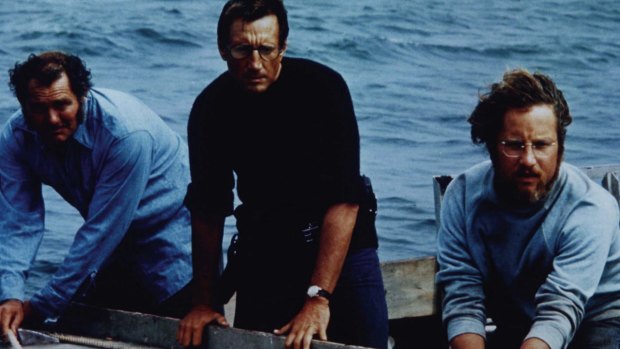By Paul Byrnes
The movie business changes slowly, until it changes fast. The fastest change ever came 40 years ago this week, when Jaws rewrote the record books for movie profitability. Every big movie since then wants a slice of that action. There were a lot of reasons Jaws made so much money so fast: opening in 450 theatres after a huge TV advertising campaign, both of which were new ideas; a great poster; the bestselling 1973 book by Peter Benchley that gave name recognition to the movie.
Those were all contributors; then there were the intangibles. One theory is that it was the right movie for America after Watergate. The weasel mayor in the horrible sports coats who refuses to close the beaches is a perfect match for the recently disgraced Richard Milhous Nixon, who left office in August 1974. In this theory, what Nixon did to American democracy, the shark did to the holidaymakers of Amity Island. It was no accident that the movie culminated on the 4th of July, America's birthday. That damned shark was Tricky Dick Nixon's half-brother!

Robert Shaw, left, Roy Scheider and Richard Dreyfuss in Jaws.
I don't really buy that idea. That kind of revisionism sounds plausible, but it's untestable. Nor does it consider the down-to-earth ways in which people choose a movie. Film critics love finding metaphors, but audiences don't necessarily give 10 cents for them. Jaws offered much more delicious and immediate attractions – the promise of fear, violence and vengeance, plus a little sex. What interests me now, 40 years later, is what else the picture offered, and how it did what it does.
It's a far better movie than most critics conceded at the time. The first 18 minutes, up to the point where the little boy is taken and his mother stands on the shore in that pathetic beach hat looking for him, is masterful on every level, but especially in the editing of Verna Fields, who won the Oscar for it. Fields taught editing at the University of Southern California, where her students included George Lucas. They called her "mother cutter". Her strategy here is interesting: "On Jaws, each time I wanted to cut I didn't, so that it would have an anticipatory feeling – and it worked".
If you'll forgive the pun, there's a lot going on beneath the surface – like the way that the camera approaches the naked girl, the first victim. During an all-night beach party, she has tried to entice a cute but drunk boy to swim with her. He passes out on the beach. We see her dangling legs and arms from about 15 metres below, as the John Williams score kicks in – da dum, da dum, da dum. We cut to her happy face, splashing about, innocent yet sexy, and then below again as the camera comes straight up towards her. The trajectory is clear – we're heading for her vagina. Cut to her face again as WHUMP, the shark connects. Visually, the inference is it's a lot like rape. Her face suggests surprise, then horror. Now she is dragged upright back and forth across screen, screaming all the while, the upright steel buoy in the back of each shot. The shark even delivers her to the buoy before taking her for one final, horrible pass in front of the camera. The sequence runs 50 seconds, and it is the moment in which Jaws announces its ambitions. It gives the horror-loving teenage audience an immediate payoff: you paid your money for something scary, here it is. There's no waiting, but plenty of Hitchcock-style suspense, conflating sex and violence, as he often did. The shark seems to have a sense of grim humour. It's a touch biblical and judgmental too: kids who drink alcohol and go skinny-dipping are breaking God's laws and shall be punished by nature.
Critics often look down on genre movies, but Jaws was never just that. It's a horror movie, a slasher movie, a chase movie; it's also a deeply personal movie for Steven Spielberg, even though he tried to get out of making it for fear of being typecast in genre. Spielberg attacks small-town American values here in a way that's almost as savage as Arthur Miller's play, The Crucible. These holidaymakers take their safety for granted; they make crass jokes even after the little boy has been taken in a sickening churn of bloody water; they swarm onto boats to hunt the shark, overloaded with beer and stupidity, chasing the $3000 reward. Mayor Vaughn (Murray Hamilton) convinces the local doctor to lie about the injuries. Vaughn caves in to the slightest pressure from the island's mediocre, money-grubbing business owners. Roy Scheider, as the police chief, is the only sane person on the island, as Richard Dreyfuss points out. Spielberg has said he cast Dreyfuss as his own alter-ego. Quint (Robert Shaw), the closest the film comes to showing its Moby Dick roots, is clearly certifiable.
To that extent, these folks deserve what they get. The shark isn't so much Dick Nixon as an avenging angel, come to smite them for being ugly and stupid white people (there is only one black face in the movie, and he's no different to the whites). Spielberg developed more compassion later, but he was just 26 when he made this, and still angry enough to want some payback on American "family values". Jaws was never just about the shark.